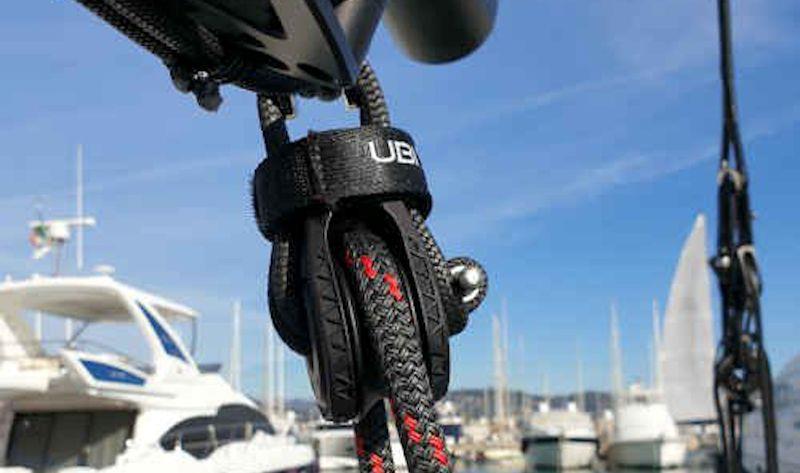
Ubi Maior X3M Flight Blocks - the compact, high flyer
by Phil Anniss 13 Jun 2020 02:00 AEST

Ubi Maior X3M Flight Blocks - the Compact, High Flyer © Ubi Maior
For 2020, Ubi Maior have re-developed and re-launched their successful X3M Flight block range. This is a small, high performance, high load block designed with flexibility in mind to make it useful for multiple applications.
The marine hardware manufacturer, Ubi Maior Italia, pride themselves in using the latest materials and production techniques to design and manufacture highly functional products that are easy to maintain and deliver optimal sailing performance.
With the latest iteration of the X3M Flight block range, Ubi Maior had two primary development objectives: improved bearing design and overall block stiffness.
Bearing system
A key element to the design of the X3M is the uni-directional Dyneema® loop which runs through the central axle. Not only does this have inherent safety benefits (i.e. if any element of the block were to fail, the loaded line would still be retained in the loop) it also allows the self-alignment of the block to the load in the running line, which reduces transverse stresses in the block. This alleviates the need for any side/thrust bearings to handle these loads and allows the use of a simple, yet highly engineered, plain bearing system.
Plain bearings are undoubtedly best in handling high load applications, but the challenge is always to find the right balance between managing high load versus reducing friction to allow decent line speeds. The primary bearing is made from a specialist techno-polymer, called Ertalyte TX with a bushing race coated with an innovative carbon coating called DLC. This coating is used in bike suspension systems and improves the X3M Flight Block line speed by 23%, even at high load.
The other potential problem for plain bearings operating at higher speed is heat, generated by friction. To manage this, the bearing and race materials are self-lubricating and the assembly of the sheave and cheeks are specifically designed to aid the dissipation of heat.
The earliest sailing blocks used simple plain bearings. Over the years, manufacturers have used highly engineered bearing systems to reduce friction and increase line speed. But now, it is advances in material technology that are allowing a return to simpler, maintenance free, plain bearing systems. This trend is being seen across all areas of performance marine hardware.
Body Stiffness
Ubi Maior Italia has for years been a pioneer in 3D printing fabrication for marine hardware, using this process to optimise the design and fabrication of custom, semi-custom and now an increasing number of their production parts.
When you are building a block to take high loads, it is imperative that the "platform" of the block is stable to ensure the high-tech bearings and other components can operate at their maximum performance, within the tightest tolerances.
Using their 3D printing experience, the Ubi Maior designers completely re-engineered the X3M Flight body and cheeks. The use of another specialist techno-polymer provides high flexural and tensile strength, stiffness and hardness yet will not break when subjected to impact or shock loading. The 3D printing process allows the density of the material to be changed throughout the structure to provide the optimum balance between strength, stiffness and weight.
Where does the Ubi Maior X3M Flight range sit relative to other blocks?
A quick top-level comparison between the Ubi Maior X3M Flight and other well-known blocks on the market, quickly highlights the fact that this is no ordinary block.
| | Harken 40mm Carbo Block - T2 Soft Attach | Ronstan S40 BB Orbitblock™ | Ubi Maior X3MFLIGHT Block |
|---|
| Sheave diameter (mm) | 40 | 40 | 40 |
|---|
| Max Line diameter (mm) | 10 | 9 | 10 |
|---|
| SWL (kg) | 544 | 700 | 2000 |
|---|
| Weight (g) | 25 | 36 | 90 |
|---|
For the same sheave diameter and line size, the Ubi 3XM Flight has 3-4 times the Safe Working Load of other blocks in this size range. This clearly shows the 3XM is aimed at high performance lines.
| | Morf Block 4 XL – High Performance | Ronstan S75 Coreblock™ | Ubi Maior X3MFLIGHT Block |
|---|
| SWL (kg) | 1500 | 1500 | 1500 |
|---|
| Sheave diameter (mm) | 60 | 75 | 32 |
|---|
| Max Line diameter (mm) | 14 | 14 | 8 |
|---|
| Weight(g) | 90 | 354 | 58 |
|---|
When you compare blocks of equivalent Safe Working Load, the Ubi X3M Flight has a significantly smaller sheave diameter, which means a very compact design, and is impressively light.
Summary
The Ubi Maior X3M Flight block range comes in ten different sheave sizes from 32mm to 120mm with Safe Working Loads from 1500kg to 15.000kg. These are light weight, high load blocks designed to cope with the demands of the latest high-tech ropes. At each size there are four different options: fixed or snatch block, with standard or long loop connectors, which can be used for a whole range of applications on board.
If you have any questions please contact us at
or browse the X3M Flight range online